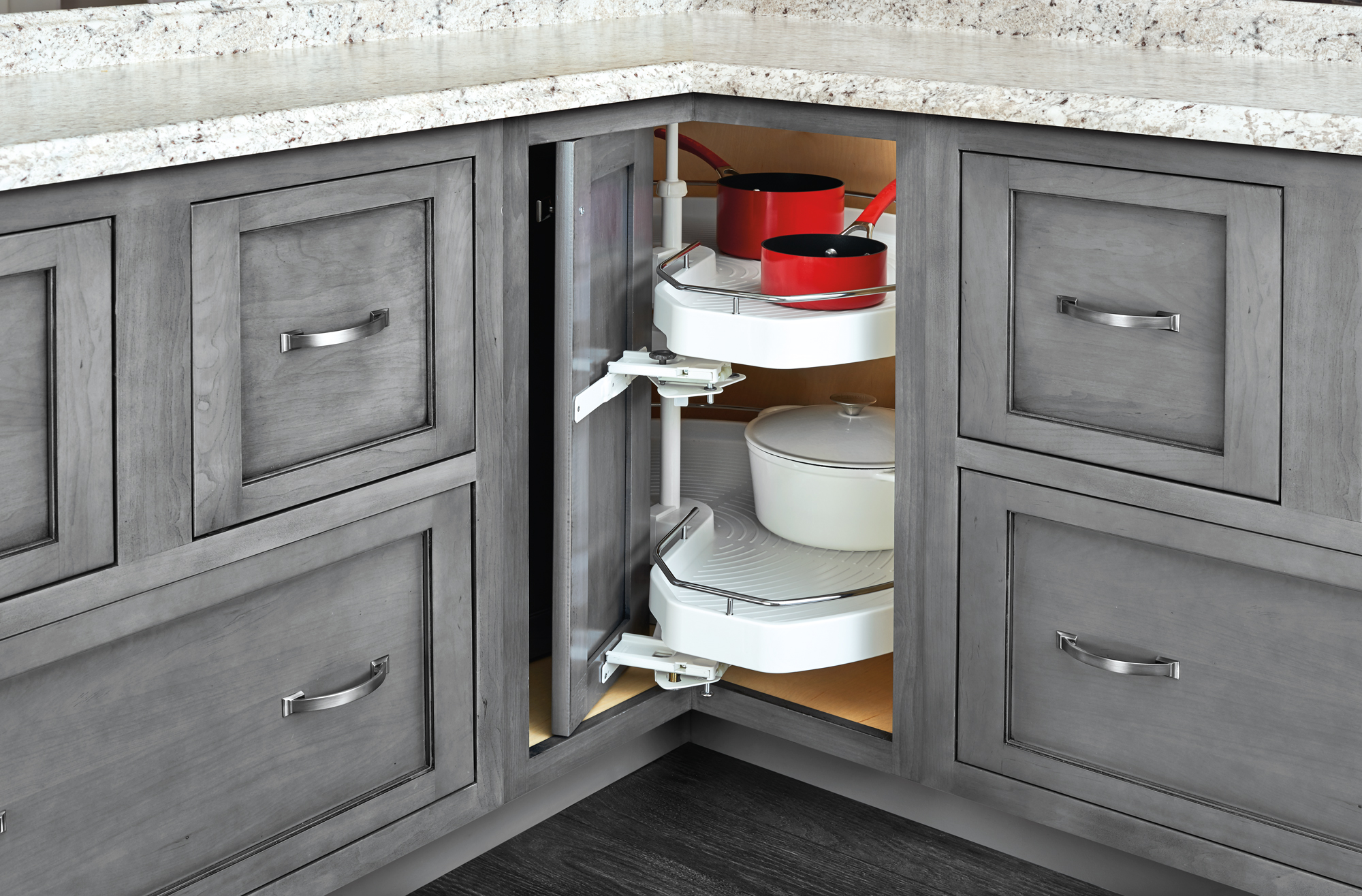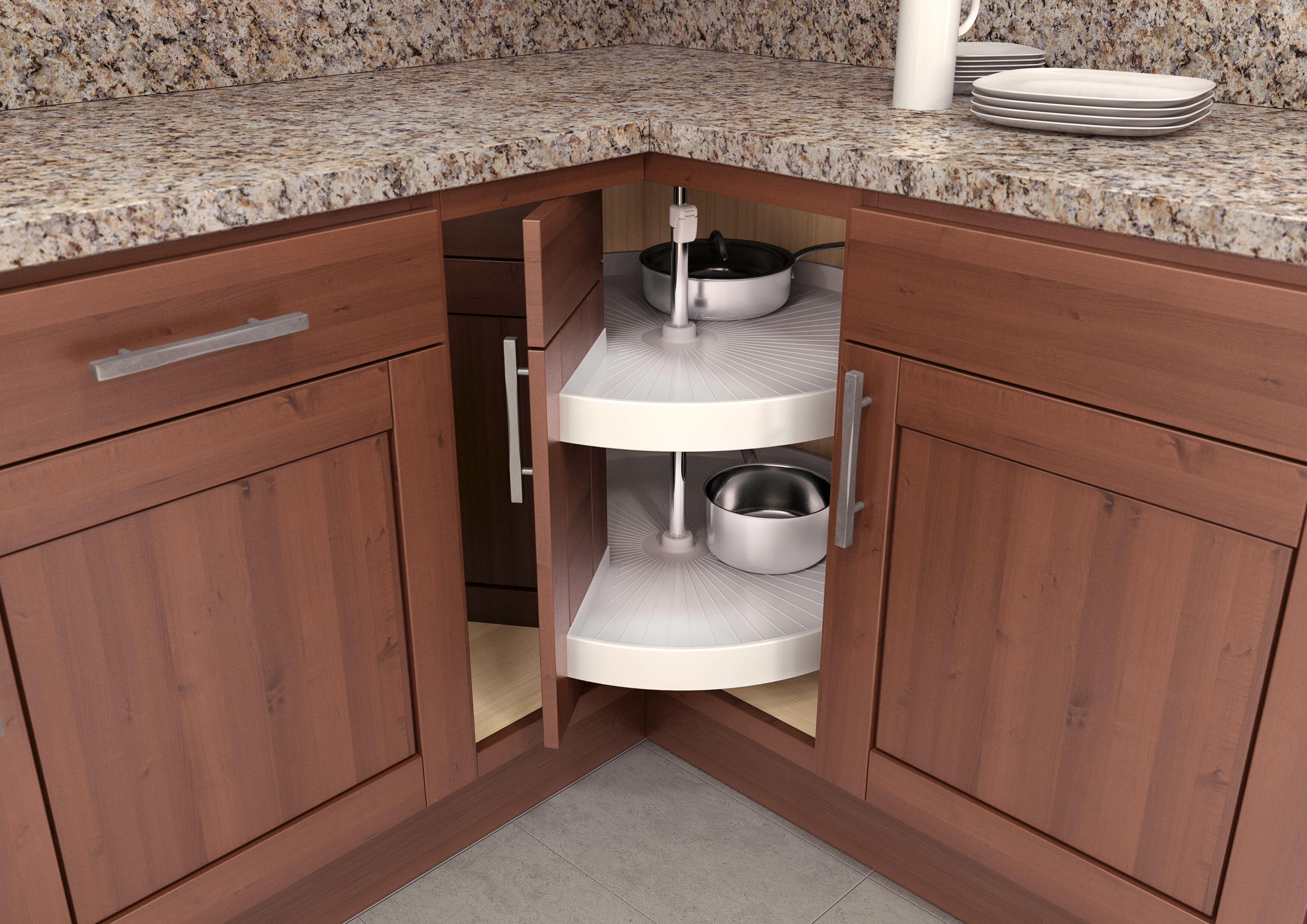Types of Lazy Susan Corner Cabinet Doors

Lazy Susan corner cabinets offer efficient use of often-underutilized space, but the choice of door style and material significantly impacts both functionality and aesthetics. Understanding these options is crucial for achieving a kitchen design that is both practical and visually appealing.
Lazy Susan Corner Cabinet Door Materials
The material of your Lazy Susan cabinet door directly influences its durability, appearance, and overall cost. Different materials offer various trade-offs, requiring careful consideration based on individual needs and preferences.
| Material | Durability | Aesthetics | Cost |
|---|---|---|---|
| Wood (e.g., solid wood, plywood, MDF) | High, especially with solid wood; susceptible to moisture damage if not properly sealed. | Highly versatile; can be stained, painted, or left natural for a variety of styles. | Medium to High, depending on wood type and finish. |
| Metal (e.g., stainless steel, aluminum) | Very high; resistant to scratches and moisture. | Modern and sleek; often used in contemporary kitchens. Can be prone to fingerprints. | Medium to High; stainless steel tends to be more expensive than aluminum. |
| Plastic (e.g., thermoplastics, melamine) | Moderate; susceptible to scratches and chipping. | Wide range of colors and finishes available; generally more affordable. | Low to Medium; melamine is typically the most budget-friendly option. |
| Glass | Moderate; prone to breakage; requires careful handling. | Elegant and adds a touch of luxury; allows for visibility into the cabinet. | Medium to High; depends on the type of glass used. |
Lazy Susan Corner Cabinet Door Styles
The style of your Lazy Susan door impacts how it integrates with your overall cabinetry and its ease of access. Three primary styles are commonly available.
Lazy susan corner cabinet door replacement – Full overlay doors completely cover the cabinet frame when closed, creating a clean, seamless look. Imagine a door that entirely hides the cabinet box sides when shut. This style maximizes storage space within the cabinet’s interior.
Half overlay doors partially cover the cabinet frame, revealing a portion of the frame when closed. Visualize a door that covers only the central part of the cabinet’s front, leaving some of the cabinet frame visible on either side. This design provides a more traditional look.
Inset doors sit within the cabinet frame, creating a flush surface with the surrounding cabinetry. Picture a door that sits recessed into the frame, creating a completely smooth, integrated surface when closed. This style is often associated with a more custom or high-end look.
Lazy Susan Mechanisms
The functionality of a Lazy Susan hinges on the mechanism that allows for its rotation. Two common types exist.
Roller bearing mechanisms utilize rollers to support the weight of the Lazy Susan tray and facilitate smooth rotation. These are typically less expensive and provide a generally smooth operation. However, they might not be as durable as ball bearing systems over extended use.
Ball bearing mechanisms employ ball bearings for superior weight support and smoother rotation. These offer improved durability and longevity compared to roller bearings, allowing for effortless spinning, even when the Lazy Susan is heavily loaded. While initially more expensive, the enhanced longevity often justifies the higher upfront cost.
Replacing a Lazy Susan Corner Cabinet Door: Lazy Susan Corner Cabinet Door Replacement

Replacing a lazy Susan corner cabinet door can seem daunting, but with careful planning and the right tools, it’s a manageable DIY project. This process requires precision and attention to detail, particularly when taking measurements. Improper measurements can lead to a poorly fitting replacement door, compromising both the functionality and aesthetics of your cabinet.
Necessary Tools and Safety Precautions
Before beginning, gather the necessary tools to ensure a smooth and safe replacement. Safety should always be prioritized. Improper handling of tools can lead to injury.
- Screwdrivers (Phillips and flathead): Essential for removing and installing screws.
- Measuring tape: Accurate measurements are crucial for a proper fit.
- Pencil: For marking measurements and positions.
- Safety glasses: Protect your eyes from flying debris.
- Work gloves: Protect your hands.
- Putty knife or similar tool: May be needed to gently pry loose stubborn components.
- Optional: Drill with appropriate drill bits, if modifications are required.
Measuring for a Replacement Door
Accurate measurements are paramount. Incorrect measurements will result in a door that doesn’t fit correctly, requiring further adjustments or even a complete replacement. Take your time and measure multiple times to ensure accuracy.
- Measure the height of the existing door from the top to the bottom edge.
- Measure the width of the existing door at its widest point. Lazy Susan doors are often not perfectly rectangular, so account for any curves or irregularities.
- Measure the depth of the door, taking into account any framing or molding.
- Note the type of hinges used on the existing door, and if possible, obtain the exact measurements of the hinge placement.
- Consider the door’s thickness. This is important for ensuring the new door fits properly within the frame.
Methods for Removing and Installing a Lazy Susan Corner Cabinet Door
Several methods exist for removing and installing lazy Susan corner cabinet doors, each with its own advantages and disadvantages. The best method depends on the specific design of your cabinet and the type of door.
- Method 1: Screw Removal: Many lazy Susan doors are attached using screws. Carefully remove these screws, keeping track of their position and length. This method is straightforward and generally safe, but may require some patience if the screws are stuck or stripped.
- Method 2: Hinge Removal: Some doors are attached via hinges that can be unscrewed or unclipped. Carefully remove the hinges, noting their position and how they attach to both the door and the cabinet. This method is generally cleaner but may require more technical skill.
- Method 3: Combination Method: Some lazy Susan doors utilize a combination of screws and hinges. Remove the screws first, then carefully disengage the hinges. This method is common and offers a balance between simplicity and precision.
The installation process generally reverses the removal steps. Ensure the new door aligns correctly with the cabinet frame before tightening screws or reattaching hinges. If modifications are needed, proceed with caution and precision.
Troubleshooting and Maintenance
Replacing a lazy Susan corner cabinet door can present unforeseen challenges. Understanding common problems and implementing preventative maintenance are crucial for ensuring the longevity and smooth operation of this often-used kitchen feature. This section details common issues, their causes, solutions, and preventative measures, along with a recommended maintenance schedule.
Common Lazy Susan Door Replacement Problems
A well-maintained lazy Susan should provide years of reliable service. However, several issues can arise during replacement or throughout its lifespan. The following table Artikels common problems, their underlying causes, practical solutions, and preventative strategies.
| Problem | Cause | Solution | Prevention |
|---|---|---|---|
| Door won’t close properly | Misaligned hinges, warped door, obstruction in the cabinet | Adjust hinges, replace warped door, remove obstruction | Regular inspection, careful door handling, periodic cleaning to prevent obstructions. |
| Lazy Susan mechanism is stiff or binds | Lack of lubrication, debris buildup, damaged bearings | Lubricate moving parts with appropriate lubricant, clean debris, replace damaged bearings (if necessary). | Regular lubrication, careful cleaning, avoiding overloading the Lazy Susan. |
| Door is loose or wobbly | Loose screws, damaged hinges, worn-out mounting hardware | Tighten screws, replace damaged hinges or mounting hardware | Regular inspection and tightening of screws, gentle use to avoid excessive stress on hinges. |
| Door doesn’t align correctly with the cabinet | Improper installation, cabinet warping | Re-install the door carefully, ensuring proper alignment. Address cabinet warping if present (this may require professional assistance). | Careful installation, maintaining proper cabinet humidity levels to prevent warping. |
| Door cracks or chips | Impact damage, inferior material quality | Replace the damaged door | Careful handling, using protective measures during cleaning. Choose high-quality materials for replacement doors. |
Maintaining Your Lazy Susan Corner Cabinet, Lazy susan corner cabinet door replacement
Proper maintenance significantly extends the lifespan of your lazy Susan and its door. Regular cleaning and lubrication are essential to prevent malfunctions and ensure smooth operation. Neglecting these aspects can lead to premature wear and tear, necessitating costly repairs or replacements.
Lazy Susan Maintenance Schedule
Regular maintenance, even simple tasks performed consistently, keeps your lazy Susan in optimal condition. Here’s a suggested schedule:
- Weekly Cleaning: Wipe down the Lazy Susan and its door with a damp cloth to remove spills and crumbs. This prevents buildup of debris that can hinder its smooth operation. Avoid abrasive cleaners that could scratch the surfaces.
- Monthly Inspection: Check all screws and hinges for tightness. Tighten any loose screws to prevent wobbling or misalignment.
- Quarterly Lubrication: Apply a food-safe lubricant (like silicone spray) to the rotating mechanism. This reduces friction and ensures smooth rotation. Avoid excessive lubrication, as this can attract dust and dirt.
- Annual Deep Clean: Remove all items from the Lazy Susan. Thoroughly clean the entire unit, paying attention to crevices and hard-to-reach areas. This will remove any accumulated grease or grime. Consider using a soft-bristled brush for hard-to-reach areas.
